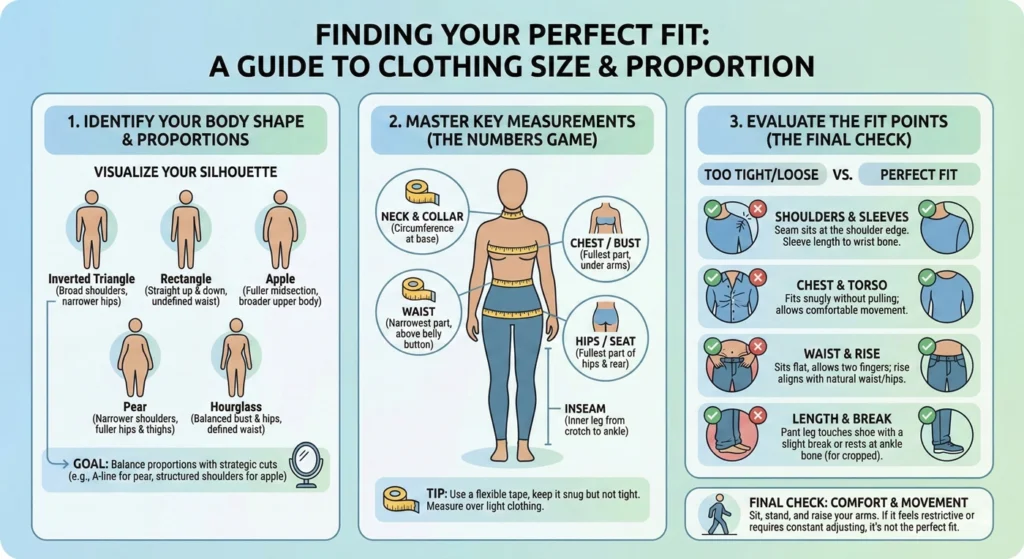Have you ever felt like something just wasn’t quite right? Maybe it was an app you launched that didn’t take off, a job that drained your energy, or clothes that technically fit but never made you feel confident. That feeling of misalignment isn’t just uncomfortable—it’s often the difference between success and failure in almost everything we do. Finding your perfect fit isn’t just a nice-to-have; it’s essential for thriving in today’s world.
- Why Most Efforts Fail to Find Their Fit
- Foundational Strategy: Identifying Strengths and Competitive Positioning
- Application 1: Finding Your Market Fit in Saturated Industries (App & E-commerce)
- Application 2: Finding Your Career Fit Based on Personality and Strengths
- Application 3: Finding Your Style Fit (Body Shape and Personal Identity)
- Final Phase: Testing, Iteration, and Go-to-Market Execution
- Conclusion: The Continuous Journey to Alignment
Why Most Efforts Fail to Find Their Fit
Let’s talk about a shocking stat: about 95% of mobile apps fail within their first year. Yikes! But why? It’s rarely because they’re badly made or totally useless. Most often, it’s because they missed their perfect market fit—they’re solving the wrong problem or targeting the wrong audience.
The concept of “perfect fit” isn’t about reinventing yourself or your product. It’s about understanding where you naturally belong and why someone should choose you over other options. Whether you’re launching an app, choosing a career, or even selecting clothes that make you feel amazing, the perfect fit is that sweet spot where your unique strengths align with what the world needs.
Here’s what you’ll learn in this guide:
- Know Yourself First: Understand your interests, strengths, and values before making big decisions
- Research and Position: Identify market gaps or niche segments where you can truly shine
- Evaluate and Test: Get real-world feedback before going all-in
- Stay Flexible: Remember that finding your fit is an ongoing journey, not a one-time decision
Foundational Strategy: Identifying Strengths and Competitive Positioning

Step 1: Honest Self-Assessment and Resource Mapping
Let’s be real—we all have strengths and weaknesses. But here’s something counterintuitive: the path to success isn’t about fixing all your weaknesses. It’s about leveraging what you’re naturally good at.
Take a moment and ask yourself:
- What activities feel more like play than work?
- When do you lose track of time because you’re so engaged?
- Where do you consistently get compliments or good results?
These questions reveal your natural strengths—the things that will give you an edge without feeling like you’re constantly swimming upstream.
And let’s talk about constraints—yes, those limitations you probably wish would go away. A small team? Limited budget? Guess what—constraints aren’t just obstacles; they’re opportunities for creative positioning. If you have a small team, you can compete on speed and personalization in ways giant corporations can’t. If your budget is tight, you can focus on niche markets that big players ignore because they’re “too small” (but perfect for you!).
Remember: The most powerful competitive advantages are the ones competitors find hardest to copy. Your unique expertise, your specific data access, or your team’s particular combination of skills—these can be your secret weapons.
Step 2: Defining Strategic Positioning and Category Fit
“We’re better than the competition” is not a strategy—it’s wishful thinking. Real positioning answers the question: “What specific role do we play in the market?”
Are you the premium option with all the bells and whistles? The budget-friendly choice that gets the job done? The specialized tool for experts? These positions shape everything from your pricing to your feature set.
For app developers, category selection is make-or-break. Choosing between “Productivity” and “Business” for your app isn’t just a label—it’s an invisible boundary that shapes user expectations and determines who you compete against. The right category tells users what your app does before they ever read your description.
The biggest mistake? Trying to appeal to everyone. Saying your product is “for all smartphone users” or “perfect for anyone who wants to get fit” sounds inclusive, but it actually makes it impossible for potential users to understand why they specifically should choose you.
Application 1: Finding Your Market Fit in Saturated Industries (App & E-commerce)

Research Methods That Provide Real Insights
Forget basic Google searches—they’ll only tell you what everyone already knows. If you want to find your perfect fit in a crowded market, you need to dig deeper.
Start by deeply using your top 10 competitors’ products. I mean really using them—create accounts, try every feature, take screenshots of confusing flows or missing options. This gives you firsthand experience of what users are dealing with.
Here’s a gold mine most people ignore: one-star reviews. These are pure, unfiltered pain points that users care enough about to take time writing down. Browse app store reviews, Twitter mentions, and Reddit threads for your competitors. Look for patterns in complaints—these are opportunities wrapped in frustration.
Pro tip: Set up Google Alerts for competitor names plus words like “problems,” “issues,” or “alternatives” to get real-time data on market frustrations.
Remember, no market is truly saturated—they always have gaps. Successful apps often focus on segments that mainstream players consider “too niche” to bother with. A fitness app for seniors or people with specific health conditions can thrive even in a sea of general fitness apps.
E-commerce Platform Alignment (Choosing Your Tools)
Finding your perfect e-commerce platform fit depends on your technical comfort level, budget, and growth plans. There’s no one-size-fits-all solution here.
If you’re a beginner seeking ease-of-use, Shopify is your friend. It’s trusted by millions, offers 24/7 support, and doesn’t require coding skills—though customization can feel limited sometimes. Wix is another user-friendly option with drag-and-drop functionality that makes site building feel like playing with digital Legos.
Already comfortable with WordPress? WooCommerce might be your perfect fit. This free plugin works within the WordPress system you already know, but be aware that scaling up with complex needs might require additional resources.
Running a larger operation with specific requirements? Magento offers open-source flexibility and enterprise-level scalability, but it definitely demands more technical knowledge (and a bigger budget for maintenance).
Application 2: Finding Your Career Fit Based on Personality and Strengths

The Fulfillment Advantage
Here’s a sobering thought: the average person spends around 90,000 hours working over their lifetime. That’s a lot of time to spend doing something that doesn’t align with who you are!
When your career fits your personality and natural talents, work feels less like… well, work. People who find their career fit perform about 20% better than those who feel misaligned, and they experience significantly less stress and burnout.
Take this real-world example: a talented professional kept struggling in consumer marketing roles that required constantly influencing others (her weakness) until she shifted to market research, which leveraged her natural superpower for analysis and uncovering insights. Suddenly, her career took off—not because she became a different person, but because she found her perfect fit.
The 4-Step Action Plan for Career Alignment
- Reflect and Assess: Start with personality assessments like Myers-Briggs or the Enneagram to understand your natural traits. Consider whether you thrive in collaborative environments or prefer independent work. Make a list of your unique strengths—not just skills you’ve learned, but things that come naturally to you.
- Narrow Down Choices: Evaluate potential careers based on what matters most to you: Growth opportunities? Salary and benefits? Flexibility? Work-life balance? Be honest about your priorities—there’s no wrong answer here.
- Test the Waters: Before making a major career shift, find ways to get firsthand experience. Internships, volunteering, side projects, or even shadowing professionals can give you valuable insights without a full commitment.
- Create an Action Plan: Set achievable goals with specific deadlines. List the resources you’ll need—whether that’s courses, certifications, or networking opportunities—and start taking small steps forward. Remember that career planning isn’t linear; be prepared to adjust as you learn more about yourself and the market.
Application 3: Finding Your Style Fit (Body Shape and Personal Identity)

Physical Fit: Matching Denim and Clothing to Your Unique Measurements
Finding clothes that truly fit isn’t just about size numbers—it’s about understanding your body shape and what styles complement it naturally.
When it comes to denim (the staple of every wardrobe), your strategy should change based on your body shape:
- Hourglass: High-rise skinny jeans will show off your natural curves, while bootcut styles create a balanced silhouette that follows your natural proportions.
- Pear Shape: Dark wash jeans have a slimming effect, while bootcut or wide-leg pants balance wider hips and thighs beautifully.
- Apple Shape: High-rise straight-leg styles define your midsection while highlighting your legs. Empire waist dresses create the illusion of a smaller waist—they’re like magic!
- Inverted Triangle: Add volume to your lower half with wide-leg or boyfriend jeans to create balance, or choose light wash styles to draw attention downward.
When it comes to sizing, remember that stretchy fabrics like knits and jersey are forgiving—you can usually stick with your regular size. For non-stretchy woven fabrics, consider sizing up for comfort. With loose, flowing designs, you might actually want to size down for a more flattering fit.
Finding your perfect bra measurement is equally important for comfort and silhouette. A bra measurement calculator can help determine your true size—many women are wearing bands too large and cups too small! Proper bra measurement makes everything you wear look better and feel more comfortable.
Identity Fit: When Clothes Match Who You Are
Have you ever owned clothes that technically fit your body but didn’t feel like “you”? That’s the authenticity gap—and it’s a common problem. Many women have closets full of items that make them feel like they’re playing dress-up in someone else’s clothes.
Your personal style should express who you truly are. Clothes communicate something about you before you even speak, so make sure they’re sending the right message! Whether your authentic style is bohemian, minimalist, classic, or eclectic, embracing it will boost your confidence immeasurably.
Building a cohesive wardrobe based on your true style makes shopping more intentional. Instead of impulse buys that sit unworn with tags still attached, you’ll create a collection of pieces that work together harmoniously, reflect the real you, and last beyond fleeting trends. This approach isn’t just better for your confidence—it’s better for your wallet and the planet, too.
Final Phase: Testing, Iteration, and Go-to-Market Execution
Critical Market Position Testing
Before going all-in on your positioning strategy, test it! Create simple landing page tests with targeted ads to measure click-through rates and sign-ups. This gives you real data about whether your positioning resonates with your target audience.
When testing, look for these three crucial signals:
- Understanding: Do people quickly grasp what you’re offering? If it takes more than 10 seconds to understand your value proposition, it needs work.
- Interest: Do people show genuine enthusiasm? Look for emotional responses and expressions of need for your solution.
- Differentiation: Can potential users explain how you’re different from competitors in their own words? If not, your positioning isn’t clear enough.
After launch, don’t just track vanity metrics like downloads or page views. Focus on engagement, retention rates, and actual problem-solving effectiveness to guide your iterations.
Positioning Mistakes That Damage Success
Avoid these common pitfalls that can derail your perfect fit strategy:
- Ignoring User Search Intent: Your positioning must align with how users actually search for solutions like yours.
- Feature-Based Positioning: Focus on benefits to users, not just lists of features. People don’t care about what your product does—they care about how it makes their lives better.
- Challenging Market Leaders Prematurely: Going head-to-head with established players without a clear, superior advantage is like bringing a butter knife to a sword fight. Find your unique angle instead.
Conclusion: The Continuous Journey to Alignment
Finding your perfect fit isn’t a one-time exercise—it’s an ongoing process of alignment and refinement. Markets shift, new competitors emerge, and personal preferences evolve. The most successful individuals and organizations remain flexible and responsive, testing assumptions and pivoting when data suggests a better direction.
Whether you’re positioning an app, choosing a career path, selecting an e-commerce platform, or even finding clothes that make you feel confident, the principles remain the same: Start with honest self-assessment, research thoroughly, test before committing, and stay open to evolution.
By building your foundation on real insights rather than assumptions, you give yourself or your business room to grow and thrive in your perfect fit space. The journey may be continuous, but the rewards—greater satisfaction, better performance, and authentic success—are absolutely worth it.
Remember that perfect fit isn’t about contorting yourself to match external expectations. It’s about finding the space where your authentic strengths meet genuine market needs—where you can be both successful and true to yourself.
What area of your life could benefit from finding a better fit? Start with one small step today—whether that’s taking a personality assessment, analyzing competitor reviews, or even just cleaning out your closet to make room for pieces that truly reflect who you are.